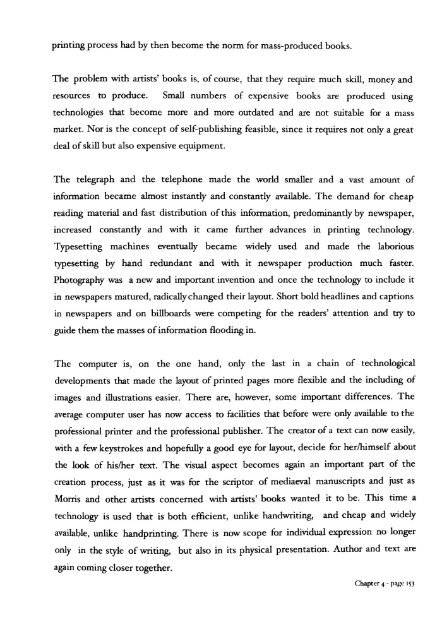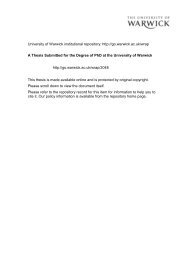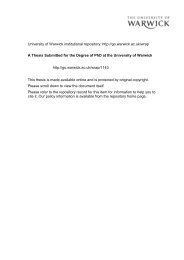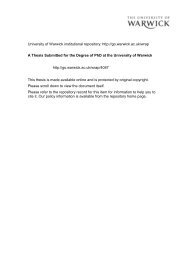From Page to Screen - WRAP: Warwick Research Archive Portal ...
From Page to Screen - WRAP: Warwick Research Archive Portal ...
From Page to Screen - WRAP: Warwick Research Archive Portal ...
Create successful ePaper yourself
Turn your PDF publications into a flip-book with our unique Google optimized e-Paper software.
printing process had by then become the norm for mass-produced books.<br />
The problem with artists' books is, of course, that they require much skill, money and<br />
resources <strong>to</strong> produce. Small numbers of expensive books are produced using<br />
technologies that become more and more outdated and are not suitable for a mass<br />
market. Nor is the concept of self-publishing feasible, since it requires not only a great<br />
deal ofskill but also expensive equipment.<br />
The telegraph and the telephone made the world smaller and a vast amount of<br />
information became almost instantly and constantly available. The demand for cheap<br />
reading material and fast distribution ofthis information, predominantly by newspaper,<br />
increased constantly and with it came further advances in printing technology.<br />
Typesetting machines eventually became widely used and made the laborious<br />
typesetting by hand redundant and with it newspaper production much faster.<br />
Pho<strong>to</strong>graphy was a new and important invention and once the technology <strong>to</strong> include it<br />
in newspapers matured, radicallychanged their layout. Short bold headlines and captions<br />
in newspapers and on billboards were competing for the readers' attention and tty <strong>to</strong><br />
guide them the masses ofinformation flooding in.<br />
The computer is, on the one hand, only the last in a chain of technological<br />
developments that made the layout of printed pages more flexible and the including of<br />
images and illustrations easier. There are, however, some important differences. The<br />
average computer user has now access <strong>to</strong> facilities that before were only available <strong>to</strong> the<br />
professional printer and the professional publisher. The crea<strong>to</strong>r of a text can now easily,<br />
with a few keystrokes and hopefully a good eye for layout, decide for her/himself about<br />
the look of his/her text. The visual aspect becomes again an important part of the<br />
creation process, just as it was for the scrip<strong>to</strong>r of mediaeval manuscripts and just as<br />
Morris and other artists concerned with artists' books wanted it <strong>to</strong> be. This time a<br />
technology is used that is both efficient, unlike handwriting, and cheap and widely<br />
available, unlike handprinting. There is now scope for individual expression no longer<br />
only in the style of writing, but also in its physical presentation. Author and text are<br />
again coming closer <strong>to</strong>gether.<br />
Chapter 4 - page 153





